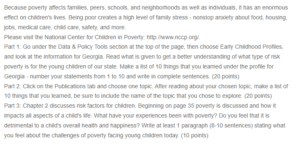National Center for Children in Poverty – Georgia
Part 1
- Georgia has policies that support the well-being of young children and their families through the two-generation framework (org). The goal is to break the cycle of poverty by addressing the needs of both generations and promoting family stability and self-sufficiency.
- The two-generation framework reflects research identifying critical supports for young children to thrive.
- Georgia ranks 42nd in state spending on preschool programs and 35th in state spending on pre-kindergarten programs, which suggests that financial resources may be scarce for providing quality early childhood education experiences (org).
- In Georgia, the income requirements for obtaining public health insurance coverage such as Medicaid and CHIP are established at a level no lower than 200% of the federal poverty line.
- Eligibility for Medicaid and CHIP is based on household income, residence status, and other factors. Immigrant children under 19 may qualify for full-scope Georgia Medicaid if they meet all the eligibility criteria.
- Temporary coverage applies to lawfully present immigrant adults and pregnant women who do not qualify for Medicaid or CHIP.
- A 12-month coverage period is available for these individuals, with the option to renew coverage after that. As postpartum coverage, women with temporary coverage are eligible for up to 6 months of Medicaid following the birth of a child (org).
- Georgia makes policy choices in early health and development, including access to and continuity of health care, preventive screening and assessment, and access to health care for parents (org).
- Georgia makes decisions about early care and education services, including access to childcare and investment in pre-kindergarten programs.
- Georgia makes policy choices to support low-income parents with young children, including TANF requirements and income support policies such as tax relief, earned income tax credits, and child support disregard.
Part 2
Hire our assignment writing services in case your assignment is devastating you. We offer assignment help with high professionalism.
Topic: Access to Health Insurance for DACA Recipients with Disabilities
- The DACA program, implemented in 2012, offers work permits and temporary protections from deportation to eligible undocumented immigrants (Heather 2).
- The DACA program engages over 200,000 people in meaningful employment and provides access to many important benefits such as Social Security and Medicare.
- The DACA program has allowed many recipients to break out of the cycle of poverty, providing a path for them to achieve economic self-sufficiency (Heather 2).
- Low-income DACA recipients undergo special scrutiny when seeking health care and other services.
- In 2018, there were over 700,000 DACA recipients in the US.
- Undocumented immigrants must meet certain criteria to be eligible for DACA, including not having been convicted of a felony or significant misdemeanor and being enrolled in school or a graduate (Heather 6).
- The year 2017 saw increased restrictions on undocumented immigrants’ access to health care, which had an especially heavy impact on DACA recipients.
- The required application fee for renewed DACA status deters many low-income recipients from reapplying (Heather 6).
- The median income of DACA recipients is significantly lower than the national average, and many cannot pay for health care.
- Washington, DC, offers key services to DACA recipients, such as access to health care and other social services (Heather 6).
Part 3
I strongly feel that poverty creates immense challenges for young children today. Lack of resources and opportunities can cause physical, mental, and emotional hardship. A child can experience physical hardship due to malnutrition, lack of access to healthcare, and other risks associated with living in poverty. Mentally, a child can suffer from stress or even depression due to the uncertainty of their future and limited options for success. Emotionally, a child may struggle with feeling different from their peers or having low self-esteem because of their circumstances. Poverty can also prevent a child from achieving their full potential and lead to a lifetime of struggling. Therefore, the impact of poverty on children and the youth must be recognized, and the necessary action must be taken to provide more supportive resources, such as quality education, nutrition, healthcare, and job opportunities so that all children can thrive.
Works Cited
Heather Koball, et al. “Access to Health Insurance for DACA Recipients with Disabilities: Regeneron Science Competition Project.” NCCP, 2021, www.nccp.org/publication/access-to-health-insurance-for-daca-recipients-with-disabilities-regeneron-science-competition-project/.
NCCP.org. “Georgia Early Childhood State Policy Profile.” NCCP, 2021, www.nccp.org/early-childhood/?state=GA.
ORDER A PLAGIARISM-FREE PAPER HERE
We’ll write everything from scratch
Question 

National Center for Children in Poverty
Because poverty affects families, peers, schools, and neighborhoods as well as individuals, it has an enormous effect on children’s lives. Being poor creates a high level of family stress – nonstop anxiety about food, housing, jobs, medical care, child care, safety, and more.
Please visit the National Center for Children in Poverty: http://www.nccp.org/.
Part 1: Go under the Data & Policy Tools section at the top of the page, then choose Early Childhood Profiles, and look at the information for Georgia. Read what is given to get a better understanding of what type of risk poverty is for the young children of our state. Make a list of 10 things that you learned under the profile for Georgia – number your statements from 1 to 10 and write in complete sentences. (20 points)
Part 2: Click on the Publications tab and choose one topic. After reading about your chosen topic, make a list of 10 things that you learned, be sure to include the name of the topic that you chose to explore. (20 points)
Part 3: Chapter 2 discusses risk factors for children. Beginning on page 35 poverty is discussed and how it impacts all aspects of a child’s life. What have your experiences been with poverty? Do you feel that it is detrimental to a child’s overall health and happiness? Write at least 1 paragraph (8-10 sentences) stating what you feel about the challenges of poverty facing young children today. (10 points)